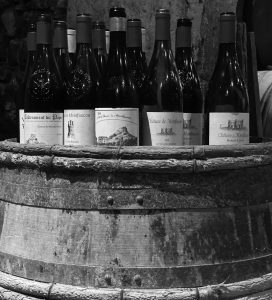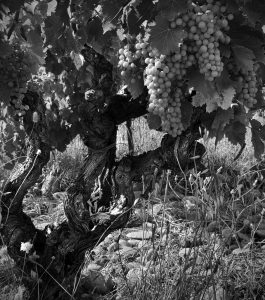 From the top of a rocky spur on the right bank of the Rhône, the château of Montfaucon faces the hills of Châteauneuf du Pape on the opposite side of the river.
From the top of a rocky spur on the right bank of the Rhône, the château of Montfaucon faces the hills of Châteauneuf du Pape on the opposite side of the river.
The first tower was built in the 11th Century, then enlarged to create a triangular fortification.
The ancestors of Rodolphe de Pins acquired the estate in 1756, but it was a century later, in 1880, when Baron Louis completed its restoration.
 The first documentation of wine being commercialised by the property was in 1829.
The first documentation of wine being commercialised by the property was in 1829.
During this period there was only a single cuvée, sold under the Le Baron label and mostly to export clients.
A vaulted wine cellar was built at the foot of the château in the 16th Century.
However, it stood, unutilised, for many years during the last Century, since its 20 hectares of grapes were delivered to the local co-operative in Roquemaure.
 Rodolphe took over the family estate in 1995, having worked apprenticeships at Vieux Telegraphe across the river in Châteauneuf and at Henschke in South Australia, restructuring and expanding the vineyards to the sixty hectares that exist today, thus continuing the legacy started by his great-great-uncle Louis.
Rodolphe took over the family estate in 1995, having worked apprenticeships at Vieux Telegraphe across the river in Châteauneuf and at Henschke in South Australia, restructuring and expanding the vineyards to the sixty hectares that exist today, thus continuing the legacy started by his great-great-uncle Louis.
The vines fall within the appellations of Côtes du Rhône, Lirac (where the family controls three large parcels and where Rodolphe spent an eight year tenure as the President of the appellation), and Vin de France (the commune of Montfaucon falls just outside the Côtes du Rhône appellation).
 There are also two more recently purchased parcels in Châteauneuf du Pape. In 2014, Rodolphe acquired a small, 1.3ha vineyard in Les Escondudes, which is located next to the fabled lieu dit of La Crau on the plateau. The parcel consists of 80 year old Grenache vines, combined with some younger Mourvèdre.
There are also two more recently purchased parcels in Châteauneuf du Pape. In 2014, Rodolphe acquired a small, 1.3ha vineyard in Les Escondudes, which is located next to the fabled lieu dit of La Crau on the plateau. The parcel consists of 80 year old Grenache vines, combined with some younger Mourvèdre.
Then, in 2019, the cellar took control of Clos Bimard, a historical estate in the Armeniers sector of the appellation, down by the river and surrounded by forest. This 3.5 hectare parcel is made up of 70 year old Grenache, Cinsault and Mourvèdre on a bench of limestone overlaid with galets roulés.
 Succession in the estate comes by the way of Léon who joined his father after studying agronomy in Toulouse and working harvests in Bordeaux, Barolo, Tasmania and Santa Barbara.
Succession in the estate comes by the way of Léon who joined his father after studying agronomy in Toulouse and working harvests in Bordeaux, Barolo, Tasmania and Santa Barbara.
Everything owned by the family was certified organic in 2010, although not the entire range of wines is certified, since two of the red wines are from bought-in grapes.
Vine age ranges from sixty to 150 years, with everything harvested by hand.
Vinification and ageing are carried out in oak vats or concrete tanks (which were installed by Rodolphe), each adapted to suit a specific parcel.
THE WINES:
Viognier, Côtes du Rhône
Despite the Rhône being Viognier’s ancestral home, it remains a challenging variety here to work with. The grapes need to be picked at optimum maturity, to ensure to capture the aromatic qualities of the grape. The challenge comes with ensuring that the resulting wine maintains freshness through managing the acid balance. The wine is fermented and aged in concrete tanks. First introduced to the range with the 2023 vintage, the wine is certified organic.
 ‘Baron de Montfaucon’ Côtes du Rhône Blanc
‘Baron de Montfaucon’ Côtes du Rhône Blanc
A blend of 80 year old Clairette vines, co-fermented in concrete tanks with Grenache Blanc and Viognier. The wine spends 9 months on the lees before bottling. There is a sense of salinity on the wine, derived from the Clairette.
The watercolour illustration on the label dates from the 19th Century and represents an image of the château from the right bank of the river.
‘Comtesse Madeleine’ Lirac Blanc
A blend of Marsanne, Grenache Blanc, Clairette and Picpoul from vineyards located throughout the appellation. Soils here range from the classic galets roulés to sand and clay. Fermentation starts in tank and is completed in barrel, then aged for nine months on the lees before bottling.
The wine is named after Rodolphe’s grandmother who managed the estate for over 70 years.
‘Vin de Mme La Comtesse’ Lirac Blanc
This unique cuvée is sourced from a 0.7 hectare parcel of Clairette purchased by Rodolphe in 2012. Established on a plateau overlooking the appellation, it was planted prior to 1870, thus making it one of the oldest vineyards in the whole of the Rhône Valley. The wine is fermented in François Frères barrels, purchased second-hand from Domaine Joblot is Givry, remaining on the lees until May following the harvest. The resulting wine is taut, saline, mineral and with a sense of Burgundy about it.
Lirac Rosé
Being the neighbouring appellation to Tavel, one would expect the cellar here to produce a traditional gastronomic Rosé. It doesn’t disappoint. First introduced from the 2022 vintage, Grenache Noir, Carignan, Cinsault and Counoise grapes undergo a 12-72 saignée before being co-fermented in foudre, then aged for six months on the lees before bottling in March. Dry (3g/l RS), although the wood ageing gives the wine a sensation of richness. It is not as deep in appearance as Tavel, but it is easy to draw the comparison.
‘Le Petit Baron’ Rouge, Vin de France
Since 1315, the Baron de Montfaucon was a fief of the Kingdom of France. The heir to the historically known as Le Petit Baron. The wine itself is a blend of varieties with an average of 40 years of age and includes Grenache, Cinsault, Carignan, Syrah, Mourvèdre and Counoise. However being located in the commune of Montfaucon itself, they fall outside the Côtes du Rhône appellation, hence the Vin de France designation. The yields are a parsimonious 20hl/ha. Co-fermented, the wine is aged in concrete tanks for 18 months before release.
Côtes du Rhône Rouge
This is from low-yielding (20hl/ha) young vine Grenache, Syrah and Carignan, raised in concrete and designed for early drinking.
Lirac Rouge
Grenache, Syrah and Carignan from ‘young’ 50 to 60 year old vines, with grapes fermented and aged in concrete vats. The label carries a watercolour dating from the 1830s and depicts two children in a carriage: a young Baron Louis and his sister, Wilhelmine.
‘Baron Louis’ Lirac Rouge
Created in 1993, this wine honours the family ancestor who restored the château and is the historical flagship of the estate. The wine comes from the best plots in the Lirac appellation, planted across three soil profiles and with a vine age of up to 100 years. 80% of the blend (Grenache, Syrah, Carignan, Cinsault and Mourvèdre) is aged for 12 months in old French oak barrels, followed by a further year’s ageing in concrete and another 24 months in bottle before release.
‘Vin de M. Le Baron’ Lirac Rouge
From the oldest and best exposed vineyards in the Lirac appellation. This is a blend of 16 different grape varieties, some of which are field blends, whilst others are independent plantings. White varieties make up 10% of the final blend, with the wine spending two years in barrel before bottling. It is then held back for a further period of ageing before release.
When, in the early 1800’s Le Baron Eugène (father of Louis and one-time mayor of Avignon) was establishing the original vineyards, it was common practice to plant many different varieties in the same parcel. With inspiration from the original Le Baron cuvée, created in 1829, the grapes are harvested at three different times to respect their difference in ripeness, however the wine is co-fermented, as it would have been back in the early to mid-1800s.
The label is as unique as the wine. When searching through a stack of old labels in the cellar archives, it was also decided to adopt the original design. This too is an ancient illustration of the rock summit of Montfaucon.
chateaumontfaucon.com
| Viognier, Côtes du Rhône | pack shot 2023 | fiche 2023 |
| ‘Baron de Montfaucon’ Côtes du Rhône Blanc | pack shot | fiche 2023 |
| ‘Comtesse Madeleine’ Lirac Blanc | pack shot 2022 | fiche 2023 |
| ‘Vin de Mme La Comtesse’ Lirac Blanc | pack shot | fiche 2021 |
| Lirac Rosé | pack shot 2023 | fiche 2024 |
| ‘Le Petit Baron’ Rouge, Vin de France | pack shot | fiche 2023 |
| Côtes du Rhône Rouge | pack shot 2022 | fiche 2022 |
| Lirac Rouge | pack shot | fiche 2021 |
| ‘Baron Louis’ Lirac Rouge | pack shot 2019 | fiche 2019 |
| ‘Vin de M. Le Baron’ Lirac Rouge | pack shot | fiche 2017 |